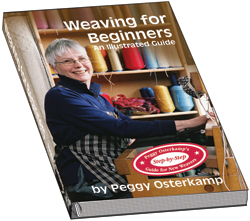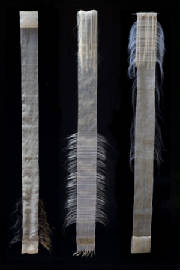 Weaving is a fundamental necessity to creating the clothes we wear – whether by machine or hand. But there is a special calling for the modern day handweaver to become proficient in this skill. After all, why weave when there are so many machines that can pop things out at lightning speed? Art and self-expression are two reasons. And for those that feel the calling, Peggy Osterkamp has documented a compendium of handweaving wisdom. Based on her many years of teaching, learning, and sharing knowledge with both students, peers and AVL icon Jim Ahrens, Peggy gives a gift to the handweavers with her latest book, Weaving for Beginners: An Illustrated Guide. An icon herself in the weaving community, this book increases the breadth and depth of her ever expanding wisdom as a modern day sage of the weaving community. It gives the new weaver – and refreshes the intermediate and advanced weaver – on the “bones” of hand weaving. Here Peggy answers some questions about her personal journey and her new book.
Weaving is a fundamental necessity to creating the clothes we wear – whether by machine or hand. But there is a special calling for the modern day handweaver to become proficient in this skill. After all, why weave when there are so many machines that can pop things out at lightning speed? Art and self-expression are two reasons. And for those that feel the calling, Peggy Osterkamp has documented a compendium of handweaving wisdom. Based on her many years of teaching, learning, and sharing knowledge with both students, peers and AVL icon Jim Ahrens, Peggy gives a gift to the handweavers with her latest book, Weaving for Beginners: An Illustrated Guide. An icon herself in the weaving community, this book increases the breadth and depth of her ever expanding wisdom as a modern day sage of the weaving community. It gives the new weaver – and refreshes the intermediate and advanced weaver – on the “bones” of hand weaving. Here Peggy answers some questions about her personal journey and her new book.
C: Did you find weaving or did weaving find you?
P: I found it! In 1975, while on sabbatical from teaching, I took a class at Pacific Basin Textiles, in Berkeley. I loved everything about it – the big learning curve and the steps involved. And I made smashing projects. In those days we made art, and it was frowned upon if you didn’t create your own project with your own idea.
That’s why when I was teaching my classes I never brought out the Marguerite Davison book – I just wanted my students to be able to make their own drafts and create their own ideas. I encouraged my students to do whatever they wanted do—art or functional—with or without original drafts.
C: Which part of the weaving process do you consider the most fun, and the least?
P: I love it when an idea strikes me from inside my body somewhere. But the hardest part is to settle on which ideas to accept and which to reject while designing a project.
C: What has been your observation as the biggest obstacle students face when learning to weave? How does your book help overcome that obstacle?
P: Beaming seems to be the hardest part to grasp. In the new beginner’s book I worked really hard on getting both the illustrations and words right to get through it step by step.
Things you would expect to find in the book are there – planning, and sett, for example. Sett which was another big thing that Jim Ahrens taught. Before Jim, no one had heard of the Ashenhurst method [www.weaving.cc/leasesticks/jan04tip.html] to calculate sett. This method of calculating sett is wonderful – and that’s why I put it in the beginner’s book.
There are also some special chapters in the book – I have a chapter on computers, and a chapter on rigid heddle weaving, both written by experts. My hope is to encourage weaving.
C: How would you describe the difference between what is called the European style of weaving and American?
P: Europeans use back to front and two (2) crosses. Americans use the front to back method. I don’t know of any other place that does it that way.
Originally when weaving came to America the European techniques were used. But then hand weaving died out. When it was revived it was looked upon as more of a philanthropic activity. The Americans didn’t want to deal with a raddle and all that, and it was more intuitive to them to use a front to back method.
C: Do you find it is more a matter of personality or proficiency when weavers get passionate about front to back or back to front warping technique?
P: What you learn first is ingrained in you and it is what you remember. I recommend that beginners learn back to front first. But if people feel proficient, they don’t need to try something else. If they run into trouble, then they need to find another way, which they will find in my book. (My feeling is that back-to-front works for any project, no matter how complex.)
A lot of my back to front students are curious about the front to back process. Teachers are teaching front to back, and many students are learning that method first. So I opened my heart to it, and included a chapter in the book about the front to back method, which was contributed by Patty Townsend.
C: I read an entry in a blog on the internet where the author, in discussing your books, made the statement “I have learnt things I didn’t know I needed to learn”. Hearing that, do you feel you have accomplished what you set out to do when you decided to write books on warping and weaving?
P: I felt just wonderful! That’s why I wrote them! Jim Ahrens – the “A” of AVL – taught us things our teachers didn’t teach us that I felt needed to be passed on.
He showed us end delivery shuttles, and no one had seen them before. He taught us about making selvages separately. He brought dobby and fly shuttle looms into the studio. These weren’t available (or known) to handweavers then—-around 1975-76 Jim taught techniques as well that nobody had learned before. We were using 60-70 ends per inch (epi) to learn those techniques.
We knew that Jim was teaching us special knowledge that might get lost or forgotten. Every time we learned something new from Jim we said “Let’s put it in the Chairman Jim folder” so we could keep those nuggets. (Chairman Mao was in China at the time so that’s why we called it the “Chairman Jim” folder.) Weavers who are already weaving often don’t touch my books because they don’t know this stuff is there, but word does get around. I did the best I could to include all those nuggets that beginners should know in my new book. Many more techniques and explanations are in the three previous books. I hope that weavers get these techniques and I hope they learn them. My advanced students ask “Why didn’t we learn this is in the beginning?” So I am documenting the techniques and passing down the knowledge that can be lost.
If people feel that the information is too complicated, they should understand that I included all the information I thought beginners would need because I don’t want to leave them in the lurch. This is what the beginner wants – there might not be a need for all the information the first time the book is used, but there is trust that it is there when needed.
 C: You have achieved recognition as author, teacher and artist. How do you balance the technical aspects of the weaving process with the creative process? Is your design process as structured as your warping and loom dressing process?
C: You have achieved recognition as author, teacher and artist. How do you balance the technical aspects of the weaving process with the creative process? Is your design process as structured as your warping and loom dressing process?
P: If I have a specific project in mind, I will do all the regular calculations for sett and all that. But even then I still add an extra yard to play with ideas that come along the way.
When I want to study something closer or play with it, I will make parameters and experiment when the loom is set up. For instance, I may not have a project but I have an idea – for example, my idea of working with fine silk and making it sheer. I decided on how wide and how long, then I completely experimented on the loom. I used really fine threads at 100 epi and then I had the idea to see what happens at 50 epi so I started to weave double weave to see what would happen. I got 5 , 6 or 7 good pieces out of that experiment.
I know the technical part. The good techniques are just the bones – I don’t have to work those out. I don’t take shortcuts. I do what needs to be done. The ideas come while weaving. I love it when the ideas come!
C: It’s clear that your book series is a progression of the weaving process. Do you consider this latest edition more of a personal growth journey?
P: For me, yes! The journey was a hard thing to do, but it brought a lot of personal satisfaction. I tried to think about how I taught my classes. I learned a lot in the ten years I taught at City College of San Francisco, and wanted to be able to pass those nuggets on.
C: What is the one basic lesson you hope a prospective reader of your latest book will learn?
P: I want readers to enjoy it and they feel that they can trust that they will find out how to do what they need to do, and if they get into some binds I am there, too.
I want them to enjoy weaving by learning the steps that need to get done. Knowing the steps so that they don’t get frustrated. I would like to emphasize that for those who are already weavers, that they will pass down this knowledge as well.
C: What is the next road on your journey?
P: I hope that I get good feedback! I feel a sense that I have given something, and I hope that is appreciated and successful!
And, I want to weave the ideas that come out!
You can access Peggy’s web site at www.weaving.cc
Now, check out an extraordinary basket maker.